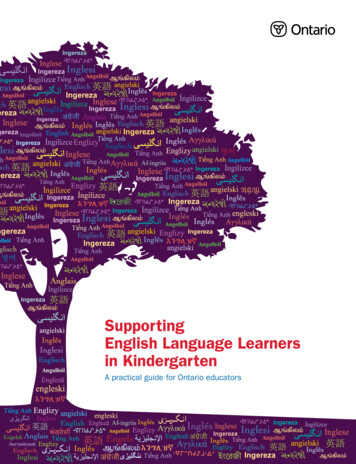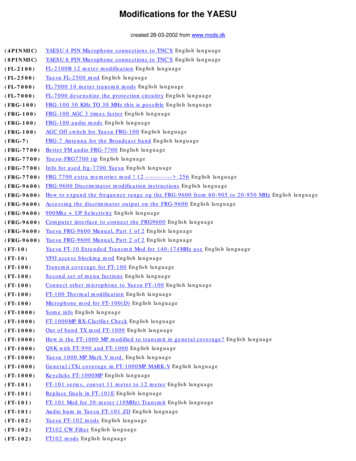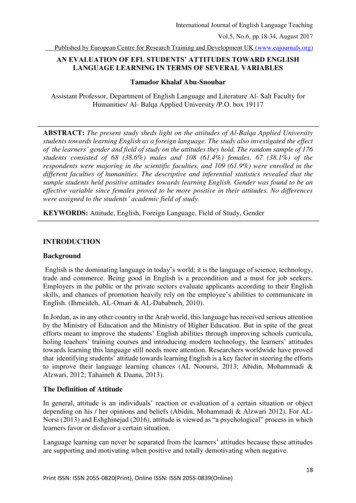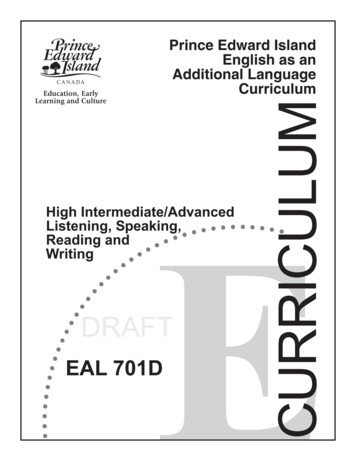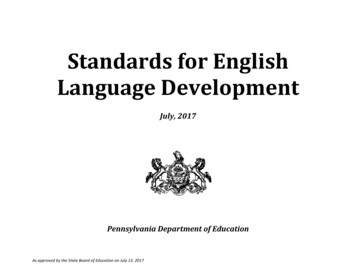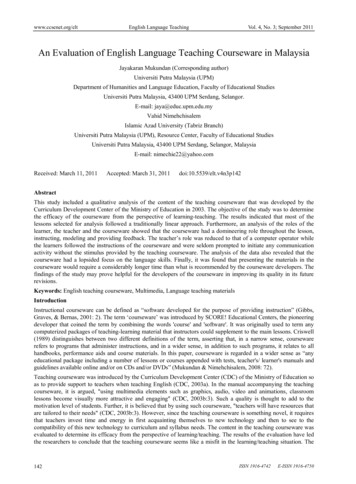
Transcription
www.ccsenet.org/eltEnglish Language TeachingVol. 4, No. 3; September 2011An Evaluation of English Language Teaching Courseware in MalaysiaJayakaran Mukundan (Corresponding author)Universiti Putra Malaysia (UPM)Department of Humanities and Language Education, Faculty of Educational StudiesUniversiti Putra Malaysia, 43400 UPM Serdang, Selangor.E-mail: jaya@educ.upm.edu.myVahid NimehchisalemIslamic Azad University (Tabriz Branch)Universiti Putra Malaysia (UPM), Resource Center, Faculty of Educational StudiesUniversiti Putra Malaysia, 43400 UPM Serdang, Selangor, MalaysiaE-mail: nimechie22@yahoo.comReceived: March 11, 2011Accepted: March 31, 2011doi:10.5539/elt.v4n3p142AbstractThis study included a qualitative analysis of the content of the teaching courseware that was developed by theCurriculum Development Center of the Ministry of Education in 2003. The objective of the study was to determinethe efficacy of the courseware from the perspective of learning-teaching. The results indicated that most of thelessons selected for analysis followed a traditionally linear approach. Furthermore, an analysis of the roles of thelearner, the teacher and the courseware showed that the courseware had a domineering role throughout the lesson,instructing, modeling and providing feedback. The teacher’s role was reduced to that of a computer operator whilethe learners followed the instructions of the courseware and were seldom prompted to initiate any communicationactivity without the stimulus provided by the teaching courseware. The analysis of the data also revealed that thecourseware had a lopsided focus on the language skills. Finally, it was found that presenting the materials in thecourseware would require a considerably longer time than what is recommended by the courseware developers. Thefindings of the study may prove helpful for the developers of the courseware in improving its quality in its futurerevisions.Keywords: English teaching courseware, Multimedia, Language teaching materialsIntroductionInstructional courseware can be defined as “software developed for the purpose of providing instruction” (Gibbs,Graves, & Bernas, 2001: 2). The term ‘courseware’ was introduced by SCORE! Educational Centers, the pioneeringdeveloper that coined the term by combining the words 'course' and 'software'. It was originally used to term anycomputerized packages of teaching-learning material that instructors could supplement to the main lessons. Criswell(1989) distinguishes between two different definitions of the term, asserting that, in a narrow sense, coursewarerefers to programs that administer instructions, and in a wider sense, in addition to such programs, it relates to allhandbooks, performance aids and course materials. In this paper, courseware is regarded in a wider sense as “anyeducational package including a number of lessons or courses appended with tests, teacher's/ learner's manuals andguidelines available online and/or on CDs and/or DVDs” (Mukundan & Nimehchisalem, 2008: 72).Teaching courseware was introduced by the Curriculum Development Center (CDC) of the Ministry of Education soas to provide support to teachers when teaching English (CDC, 2003a). In the manual accompanying the teachingcourseware, it is argued, "using multimedia elements such as graphics, audio, video and animations, classroomlessons become visually more attractive and engaging" (CDC, 2003b:3). Such a quality is thought to add to themotivation level of students. Further, it is believed that by using such courseware, "teachers will have resources thatare tailored to their needs" (CDC, 2003b:3). However, since the teaching courseware is something novel, it requiresthat teachers invest time and energy in first acquainting themselves to new technology and then to see to thecompatibility of this new technology to curriculum and syllabus needs. The content in the teaching courseware wasevaluated to determine its efficacy from the perspective of learning/teaching. The results of the evaluation have ledthe researchers to conclude that the teaching courseware seems like a misfit in the learning/teaching situation. The142ISSN 1916-4742E-ISSN 1916-4750
www.ccsenet.org/eltEnglish Language TeachingVol. 4, No. 3; September 2011material was found to be violating some important principles in language learning/teaching and specifically, theprinciples and theories that support materials development for language learning/teaching. What Weible (1984) putforth three decades ago about the teaching courseware of his time may also apply to most courseware developednowadays in that “the currently available foreign language microcomputer courseware is meagre in quantity andgenerally unimpressive in quality” (p.63).Computers and technology have drastically changed the face of education in recent years. However, languagelearning material developers and teachers should approach technology very cautiously. While there is no empiricalevidence evaluating learner attitude toward teaching through multimedia and teaching courseware in Malaysia (Lily& Muhamed, 2000), some researchers warn, "the screen-by-screen approach to the operation of the teachingcourseware would give the impression that this is a lecture and not a lesson," (Mukundan, 2008:108). It is alsoargued that the successful application of CD-ROM courseware in content-based subjects, like science (AiniArifah &Norizan, 2008), does not necessarily mean it is applicable in the language classroom (Mukundan, 2008).In order to make the best possible use of it teachers should distinguish between the two types of educationalsoftware, LMS (Learning Management System) and VLE (Virtual Learning Environment) (Lewis, 2008). WhileLMS includes the types of software used to deliver, track and manage training, VLE embraces software systemsdeveloped to assist teachers and learners in educational settings. Educational software may be either providing aseries of lessons revealed to the learner periodically (LMS) or unveiling the whole course all at once leaving thelearner free to select (VLE). As Lewis notes, it is of importance to differentiate static types of software that presentready-made exercises with an accompanying key from dynamic programs that suggest options and possibilitiesthrough which learners can choose in their learning experience. The former is referred to as only an 'object' but thelatter as a 'tool' (Lewis, 2008). Providing learners with mere objects will hinder their interest and creativity whereastools involve and attract learners guiding them to develop their own materials.The Malaysian English Teaching Courseware (Form 1)Curriculum Development Centre (2003a) developed the Form 1 English Language courseware. It includes 28 units.Each unit consists of five lessons, so there is a total of 140 lessons in a package of nine compact disks. These comealong with five other CDs, called Teacher's Courseware Resource Guide, which include the two main sections ofTeacher's Training and Teacher's Resources. The Teacher’s Training section is a manual accompanied by severalvideos. The manual introduces the courseware, provides guidance on the installation of the necessary equipment,guides the teacher on issues like the teaching plan as well as time management, and finally provides sometroubleshooting tips. The videos introduce the courseware and explain how to use it in the classroom.Each lesson of the courseware consists of PDF files including Teacher's Notes, Activity Worksheets, andAudio-video Scripts. The courseware offers a variety of activities in the form of fill-in-the-blank, drag-and-drop,multiple-choice or marking, true/false, and rearrange pictures/sentences exercises. Every lesson comprises the sixparts of introduction, content, activity, evaluation, enhancement and extension. The introduction prepares the classfor the new lesson through reading or listening activities. The content exposes the learners to language forms andfunctions emphasized in the lesson. The section presents the main topic of each lesson. In the activity section, thelearner plays a more active role. It involves guided writing or speaking activities that help the students practice whatthey have learned in the content section. Evaluation is the fourth section where the learners are expected to producethe new function or form they have learned in response to verbal or pictorial stimuli. The section checks students'understanding of the new lesson. The next part of each lesson is called enhancement. It helps the learner furtherconsolidate the new lesson in their minds. It provides remedial exercises for those students who had certainproblems in the evaluation section. This screen may include two or more sub-screens arranged in order of theirdifficulty level. The first practice is for students who have some difficulties with the content of the new lesson whilethe second practice contains enrichment activities for students to explore the topic. The final section is extension thatoffers additional tasks that allow them to personalize the new lesson. These activities can be completed outside theclassroom as homework.Objective and Research QuestionsThe study aims at evaluating the efficacy of the teaching courseware in the learning/teaching environment. Based onthis objective, the following research questions are posed:1.To what extent is the courseware in line with the principles of second language methodology?2.How efficient and consistent are the anticipated roles of the learners, teacher and material?3.Does the courseware emphasize the language skills (listening, speaking, reading and writing) equally?How practical is the time management scheme suggested by the teaching courseware manualPublished by Canadian Center of Science and Education143
www.ccsenet.org/eltEnglish Language TeachingVol. 4, No. 3; September 2011MethodTwo units from the courseware were randomly selected and qualitatively analyzed to investigate the teacher, learnerand material roles in order to answer the first and second research questions. Three English as a Second Language(ESL) instructors evaluated the courseware. They were female Malaysian instructors with a minimum experience of12 years of teaching. After they were cross-checked for consistency, the data were summarized and tabulated tofacilitate later reference. Appendix A provides a sample of the tabulated data. Additionally, Appendix B illustratesthe tabulation of the overall qualitative analysis of the two units. Moreover, the exercises focusing on each languageskill were quantified to show the proportion of focus on each language skill (Figure 1). In order to answer the finalresearch question the three English Language Teaching (ELT) experts predicted the necessary time to cover eachlesson. The data were collected and tabulated. The mean of the time allocations was then compared with therecommended time by the developers of the courseware (Table 1).ResultsWith regard to the first research question; that is, the extent to which the courseware follows the principles ofEnglish Language Teaching, it was found that some crucial ELT techniques were neglected in its development. Asthe results showed, the courseware did not adhere to the principles of materials development (Tomlinson, 1998). Itscontent structure and delivery indicated that the teaching courseware stood isolated from Approach (body of theorythat supports a method) and Procedure (the way the learner, teacher and material play roles in the classroom). Asthe results showed, time-tested methods could not be incorporated into the lessons where the teaching coursewarewas used. According to the principles of methods like the Total Physical Response (TPR), Audio-Lingual Method(ALM) or Communicative Approach to Language Teaching (CALT) the teacher, learner and materials should workin harmony to create and re-create language. The teacher using the courseware, however, would often be amanipulator of hardware and the lesson would be more teacher-centered as opposed to learner-centered.The findings indicated that the teaching courseware ignored the value of incorporating well-established ELTmethods. It was rather based on a traditional and linear approach. It followed the conventional presentation, practice,and production (PPP) approach, in which, first, a topic is introduced to the learner, and then the learner does a seriesof guided activities related to the topic. This was evident from the titles of the different sections of each lesson. Theintroduction and content screens presented the linguistic form or function that the learner was expected to learn. Theactivity and evaluation screens that followed sought to help the learner practice the new lesson. Finally, theenhancement and extension screens aimed at eliciting the desired linguistic product from the student.As warned by the researchers in the area of ELT material development and evaluation, the application ofunsophisticated multimedia developed for language instruction usually does nothing more than providing learnerswith similar content from conventional materials (Mukundan, 2008). A considerable part of the teaching coursewareincluded still-screen multimedia with simple animation. This would suggest that the courseware fell under thecategory of educational software programs that are static and merely provide learners with activities that could bepresented using textbooks anyway.To anticipate the roles of the teacher, learner and teaching courseware (research question 2) the lessons wereanalyzed and the results of the evaluation were summarized and tabulated (Appendices A and B). According to thefindings, the teacher most of the time would act as a computer operator, who does nothing more than clicking andoperating the teaching courseware. Once a new screen is called up, the courseware automatically reads out theinstructions to the class. This can turn to a nuisance element if the teacher fails to mute the speakers or is unable toclick on the listening icon to deactivate it.As for the learners, they would be expected to follow the PPP approach. At the beginning of the lesson, they wouldbe more passive and rather reactive, responding to some guided verbal or visual stimuli. Towards the end of eachlesson, however, they would be productively able to manipulate the linguistic elements they had learned. Pair/groupwork was sometime encouraged. The activities were mostly content-driven and the students were stimulated by thescreens to communicate, so they would not be allowed to initiate any communication activity. A few screens aimedat engaging the student in problem-solving activities in imaginative ways. A few activities personalized or localizedthe topic.As it was evident from the emerging results, the teaching courseware was the domineering element throughout eachlesson. It presented the instructions and examples. It provided the students with feedback as well as the correctresponses to the exercises. Explicit focus on the forms and functions of language was sometimes evident.Surprisingly, instances of conflict in the teaching agenda in the courseware could be observed. As an example, inone of the exercises, although the instructions directed the learners to listen and write their answers, the material inthe recording appeared both in the worksheet and in the screen that eliminated any need for listening anyway. Some144ISSN 1916-4742E-ISSN 1916-4750
www.ccsenet.org/eltEnglish Language TeachingVol. 4, No. 3; September 2011of the worksheets were exactly the same as the screens. This would emphasize the assumption that a textbook couldalso do what these screens were trying to do. Only in a few cases were the screens manipulated efficiently bydisclosing the content slide by slide thereby adding suspense to the learning experience. However, sometimes thescreen automatically flipped visuals that could easily distract the learner if the machine were not muted or the videoprojector were not blocked.As for the third research question, a lopsided focus on listening, writing and reading activities was observed. AsFigure 1 indicates, about one in three activities in the courseware focused on reading (28%), writing (29%) orlistening (30%) while very few concerned speaking (13%). This suggests that the learner is given less opportunity topractice speaking as compared to the other language skills.In order to answer the last research question the three language teachers predicted the required time for each lessonto be presented. The experts individually examined the lessons and recorded the time required for each lesson to becovered in a real language classroom. This helped the researchers to cross-check the allotted time to come up withmore reliable data. According to the manual, a period of 40 minutes was assumed to be enough to cover each lesson.The teacher was recommended to spend 3, 10, 10, 5, 7 and 5 minutes on the introduction, content, activity,evaluation, enhancement and extension, respectively (CDC, 2003b: 14). Table 1 depicts the average time predictedby the experts. A comparison of the table and the time recommended by the courseware developers shows that thescheme has been proposed in ad hoc manner and that a teacher who wishes to use the teaching courseware woulddefinitely come short of time.DiscussionAccording to its developers, the electronic courseware seeks to raise the standard of teaching by providinghigh-quality teaching resources (CDC, 2003b). It is claimed that the courseware can engage the students by usingvisually attractive multimedia and adding variety to lessons from the usual practice of using only books andchalk-and-talk. The courseware may also help ESL teachers by lightening their workload in material developmentCDC (2003b).When it embarked on the development of the teaching courseware, the CDC had good intentions. The teachingcourseware, however, was found to be inappropriate for language teaching. As the results showed, it might lead to alack of harmony within the learning-teaching situation for at least four reasons that are discussed in this section.To begin with, the role of the teaching courseware is unclear within the curriculum. As it can be inferred, the CDCrecommended the exclusive use of the teaching courseware. There is clear evidence on this when they produced 140lessons, more than the number of lessons in a school year. In addition, it was mandatory for teachers to use it.Indeed, supervision of teachers was carried out when it was first implemented, which resulted in confusion amongteachers – the textbook which was newly commissioned in 2003 seemed to have lost out in a case of competingresources.Second, as it emerged from the findings, the teaching courseware lacks the sophistication expected of multimedia.Most of its content resembles that of language textbooks, which means pages from a book merely digitized with theaddition of windows that operate on click and drag routines. Admittedly, use of technology may add to novelty tolanguage teaching. However, novelty, as introduced by the courseware, very easily wears off.What is more, the courseware seems unable to exploit contemporary methodology expected within ELT materials.The courseware mostly follows the traditional PPP approach that is linear and rather inflexible. Language teachersfamiliar with the ELT methodologies will not be able to incorporate them in their teaching while using thecourseware. Methods like the TPR, Suggestopedia and CALT will not feature much when the teaching coursewareis used since they cannot easily fit into the prescribed script produced by the developers. The courseware wouldlimit a teacher who wishes to teach listening comprehension using the TPR method since it would require learners'listening and performing physically throughout. The method focuses more on comprehension than on the oralproduction of language on the part of the learner. However, the courseware does not prompt such activities.The role of the teacher is reduced to that of a computer operator and the learner-centeredness expected of thelearning-teaching situation is diminished since the courseware seems to be doing all the work. The instructions foreach activity are read out for the students. Teachers, who are novice or lack the experience of using technology inthe language classroom, may fail to mute the courseware once it is switched on, which can distract the learners. Theteacher has to stand by the computer and have students follow the instructions and then with the help of the softwaremonitor the responses from the students. The developers provide the correct answers for every activity, but fail toguide the teacher on how to use this material, which may tempt novice teachers to show students the answers afterPublished by Canadian Center of Science and Education145
www.ccsenet.org/eltEnglish Language TeachingVol. 4, No. 3; September 2011every exercise. This will lead to a technology-centered classroom where the conventional role of learners andteachers is to work together on the materials to learn and produce the language forms and functions.ConclusionAs the results of the study indicated, the courseware does not appear to have been developed based on thecontemporary ELT principles. The considerable budget that was dedicated to its development has interestingimplications in the allocation of financial resources for educational purposes. Such an investment sounds unjustifiedwhen the recently developed school textbooks cost billions of ringgit. In such a situation it would be morereasonable to ensure the textbooks were not neglected. Developing supplementary materials to make the textbooksmore useful would have been more appropriate than investing in a new material to replace the textbooks. This doesnot sound like a wise investment decision.Of course, investment on educational technology, especially multimedia, is not a crime. As found in this study,technology in the form of the present teaching courseware looks primitive and lacks sophistication. It has severalscreens that look like pages of textbook that have been digitized. Such a massive investment on new technology hadto be deliberated with experts in the related areas and classroom teachers before making decisions on itsdevelopment. Prior to being commissioned into classrooms, any new product must be examined and field-tested.The courseware fails to emphasize the commonly prescribed roles of the teacher, learner and materials. The roles ofthe teacher, learner and materials are not cohesively knit together within procedure in language classrooms.One possible way to use the courseware more effectively would be to encourage the teacher to regard it as asupplementary material that can be cannibalized for revised teaching approach. Further research is needed tore-examine the performance of the teaching courseware in the real classroom setting. Nevertheless, as it can beassumed, the results of such a re-evaluation would indicate it usurps the role of the teacher that is against thewell-established rules and theories of language teaching.ReferencesAiniArifah, A.B., & Norizan, M.Y. (2008). Using teaching courseware to enhance classroom interaction as a methodof knowledge sharing. Journal of Information Systems, Research & Practices, 1(1), 1-12.Criswell, E.L. (1989). The design of computer-based instruction. New York: Basic Books.Curriculum Development Center (2003a). Teaching Courseware: English Language Form One. Ministry ofEducation. Malaysia.Curriculum Development Center (2003b). Teaching Courseware: Teacher's Manual. Ministry of Education.Malaysia.Gibbs, W., Graves, P.R., & Bernas, R.S. (2001). Evaluation guidelines for multimedia courseware. Journal ofResearch on Technology in Education, 34 (1), 2-17.Lewis, G. (2008). Making the most of technology: Materials design for a wired world. Speech delivered at the 4thInternational Conference on ELT Materials, 16 October, Melaka, Malaysia.Lily, O, & Muhamed, M. (2000). Factors associated with learners' attitude towards learning through CD-ROMcourseware: A case study of the Discovery Center, Binariang Berhad. International Conference Proceeding:Education and ICT in the new millennium.Ministry of Education. (1999). Mesyuarat Tayangkaji Perisian Kursus Multimedia Pendidkan Interaktif PasukanKhas Kementerian Pendidikan Malaysia 1/99. Bahagian Teknologi Pendidkan.Ministry of Education (1997). The Malaysian smart school: A conceptual blueprint. Kuala Lumpur: Government ofMalaysia.Mukundan, J. (2008). Multimedia materials in developing countries: The Malaysian ELT experience. In Tomlinson,B. (ed.) English language learning materials: A critical review. London: Continuum International PublishingGroup.Mukundan, J. & Nimehchisalem, V. (2008). Educational software and English teaching courseware: Promisingpanaceas? Journal of Nepal English Language Teachers’ Association (NELTA). 12(1-2), 71-79.Tomlinson, B. (1998). Material development in language teaching. Cambridge: Cambridge University Press.Weible, D. (1984). The foreign language teacher as courseware author. The Computer Assisted LanguageInstruction Consortium Journal (CALICO), 1(1), 62-64.146ISSN 1916-4742E-ISSN 1916-4750
www.ccsenet.org/eltEnglish Language TeachingVol. 4, No. 3; September 2011Table 1. Estimated time to cover each lesson (in minutes)Unit 10ScreenUnit l time1017776918478971008457Key) L: ngWritingSpeaking13%Reading28%Figure 1: Distribution of focus on the language skills in teaching courseware content (%)Appendix A: Sample Qualitative Analysis Tabulation of Unit 11, Lesson 1IntroductionTeacher's roleOperating;facilitating:warmingStudent's roleup;Listening to and answering questionsCourseware roleProviding a simple animation to facilitatemanipulating questions to check for Ss'the presentation of the word big bike; asking(students’) listening comprehension, and toquestions to trigger Ss' speakingadvance organizeTime managementInstructions: 00:20Total: 10 minutes) warming up (5 minutes), discussion (5 minutes)Published by Canadian Center of Science and Education147
www.ccsenet.org/eltEnglish Language TeachingVol. 4, No. 3; September 2011ContentTeacher's roleStudent's roleOperating: clicking pop-up icons to provideListening & reading; responding follow-upFocusSs with examples; observing and ensuringquestions to show understanding form ofconsciousness on past tense; 3 subscreens:Ss' understandingpast tense verbs & questionssimple & still picturesInstructions: 01:23Listening: 02:36Time managementCourseware roleTotal: 25 minutes) Contents 1&2 (10 minutes each),onform:explicitraisingSs'Content 3 (5 minutes)ActivityTeacher's roleStudent's roleCourseware roleReduced: merely operating the computerListening to specific information, writingInstructing, directing and correcting Ss;and handing out the worksheetsanswerswhatever appears on the worksheet is alsohanded out to Ss rendering the screen and itsstill illustration redundantTime managementInstructions: 00:08Listening: 01:15 (may be repeated)Total: 12 minutes) presentation (2 minutes), listening (5 minutes), feedback (5 minutes)EvaluationTeacher's roleStudent's roleCourseware roleReduced: operating the computer andReading & changing sentences to past tense;Focusdistributing worksheetscooperative: checking answers in pairsgrammar instruction as common in theonform:conventionalexplicitGrammar Translation Method; Instructing,directing and correcting Ss; unnecessaryscreens: all repeated in worksheetsInstructions: 00:11Time managementTotal: 16 minutes) presentation (1 minute), practice (10 minutes), sharing and feedback (5minutes)EnhancementTeacher's roleStudent's roleCourseware roleReduced: operating the computer andReading & changing sentences to past tense;Focusdistributing worksheetscooperative: checking answers in thing repeated in worksheetsInstructions: 00:21Time managementTotal: 10 minutes) presentation (1 minute), practice (6 minutes), sharing and feedback (3minutes)148ISSN 1916-4742E-ISSN 1916-4750
www.ccsenet.org/eltEnglish Language TeachingVol. 4, No. 3; September 2011ExtensionTeacher's roleStudent's roleCourseware roleReduced: clicking and referring to theProductive; focused much on product ratherLetter writing: modeling not adequate,screen to provide modelsthan process of writing: concerned withaudience not specifiedwriting a letter and not with changingsomebody's mind about traveling to aswampInstructions: 00:23Time managementTotal time for the lesson: 78 minutesTotal: 5 minutes) homework task presentationAppendix B: Pedagogical Roles Analysis TablesNote: The first number in the brackets refers to the unit number followed by the lesson number(s).IntroductionTeacher's roleStudent's roleCourseware roleFacilitating: warming up SsInitially listening/reading (all lessons);Focus: language functions(10:1), form (10:2; 11:1), form andby asking pre-listeningReacting: responding screen T’smeaning (10:3-4; 11:4), meaning (11:5); reading skills (11:2);questions, presenting the(teacher's) instructions, and T'swriting skills (10:5; 11:3); Directing (all lessons): reading outmaterial (all lessons);questions (all lessons); Active:instructions; modelingOperating the computer (allnegotiating ideas (10:3,5;11:1,4);Multimedia: audio and still pictures, providing what a booklessons); Manipulatingcreative (predicting 10:3; imaginingwith a cassette-player can do (10:1,3; 11:3,5), simple animationquestions to elicit S response10:5); exploring (formal/ informaland audio (10:2; 11:1,2,4), step-by-step disclosure of content(all lessons)language differences 10:4); cooperative(10:4,5), nuisance element (1
courseware had a lopsided focus on the language skills. Finally, it was found that presenting the materials in the courseware would require a considerably longer time than what is recommended by the courseware developers. The findings of the study may prove helpful for the developers of the courseware in improving its quality in its future .
